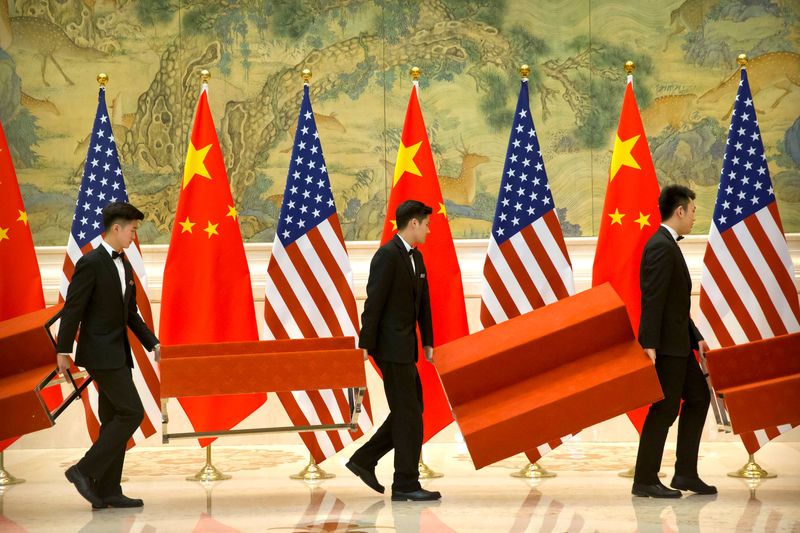

By Lisa Baertlein and Jason Lange
LOS ANGELES/WASHINGTON (Reuters) – The first time President Donald Trump threatened tariffs on the luggage that Tiffany Williams imports for her Texas store, she stockpiled high-end suitcases and other products ahead of the deadline to protect profits.
This time, she may not have that option.
Trump on Sunday vowed to lift tariffs on $200 billion of Chinese imports to 25 percent from 10 percent by the end of this week if no trade pact is sealed between the world’s two largest economies.
Williams sources about 85 percent of the products for her business, Luggage Shop of Lubbock, from China, and she bought heavily before Trump’s first round of 10 percent hit last fall.
“This time we will not have that opportunity. We won’t be able to load up,” said Williams, who voted for Trump.
Her sales are down since November, under pressure from tariff-related sticker-shock on her mainstay high-end products and competition from online rivals like Amazon.com Inc.
In an email on Monday she shared with Reuters, Samsonite told her it would again raise prices to match the tariffs- if Trump makes good on his threat.
“We are optimistic this sabre rattling ahead of the planned China/USA trade meeting this week will be reversed,” the email said. Samsonite did not immediately respond to requests from Reuters for comment.
Trump has insisted that China has picked up the tab for his tariff campaign, not American consumers.
But prices are up on a host of products as diverse as bicycles, sewing machines and pet supplies, and government data shows U.S. consumers have already had to pay more since the first round of tariffs kicked in last fall.
The price of sewing machines, which were hit in September by the original 10 percent tariff rate, have risen 10.3 percent in the 12 months through March. That is the biggest annual gain since the Labor Department started tracking prices for the appliance in 1997.
Trump also ordered 10 percent tariffs on pet supplies and bicycles. The inflation rate for pet supplies rose to 4 percent as of March, while the rate for bicycles and related sporting equipment went from about zero in October to 3 percent in March.
Research from the Federal Reserve Bank of New York, Princeton and Columbia universities, published in March, estimated the tariffs cost U.S. consumers at least $6.9 billion last year.
<p class="canvas-atom canvas-text Mb(1.0em) Mb(0)–sm Mt(0.8em)–sm" type="text" content="(For graphic on tariff pressures, click https://tmsnrt.rs/2Wvh0jU)” data-reactid=”37″>(For graphic on tariff pressures, click https://tmsnrt.rs/2Wvh0jU)
FRONT LOADING
In a comment letter last year objecting to the tariffs, Walmart Inc warned that retailers would be pressured to raise prices on car seats, cribs and backpacks.
<p class="canvas-atom canvas-text Mb(1.0em) Mb(0)–sm Mt(0.8em)–sm" type="text" content=""For lower-income families, a 25 percent tax on these items would be a serious burden on household finances," Walmart wrote https://assets.documentcloud.org/documents/5990947/Walmart-Letter.pdf.” data-reactid=”41″>”For lower-income families, a 25 percent tax on these items would be a serious burden on household finances,” Walmart wrote https://assets.documentcloud.org/documents/5990947/Walmart-Letter.pdf.
Walmart and rival Target Corp were among a swarm of retailers that pulled forward shipments of apparel, microwaves and furniture before the original Jan. 1 deadline for tariffs to rise to 25 percent from 10 percent. Walmart and Target declined comment on the newest developments.
To be sure, most U.S. consumer prices have risen only modestly since September when Trump imposed the first 10 percent levies. The tariffs largely hit components of consumer goods rather than final products, diffusing the impact across America’s $20-trillion economy.
Some companies also accepted lower profit margins in order to keep from passing higher costs onto consumers. Overall prices, as measured by the Labor Department’s consumer price index, rose just 1.9 percent in the 12 months through March.
Tom Derry, chief executive at the Institute for Supply Management, which surveys purchasing managers at major business each month, said many companies appeared to be treating tariffs as a temporary nuisance. That has made it easier for suppliers and purchasers to split costs between them in the interest of future business relations.
But a jump in tariffs to 25 percent would signal a more enduring rise in costs and hit bottom lines harder for companies that buy and sell those goods. “No company’s profit margin can stand that intense of a hit,” Derry said.
Steven Smith, owner of Luggage & Leather Depot in Bethesda, Maryland, said a jump in tariffs to 25 percent “would absolutely kill our business.” He said his sales are off as much as 20 percent after he raised prices to reflect the higher costs.
“If it goes to 25 percent, forget it. People reach a limit,” Smith said.
(Reporting by Jason Lange in Washington and Lisa Baertlein in Los Angeles; Editing by Dan Burns and Leslie Adler)






